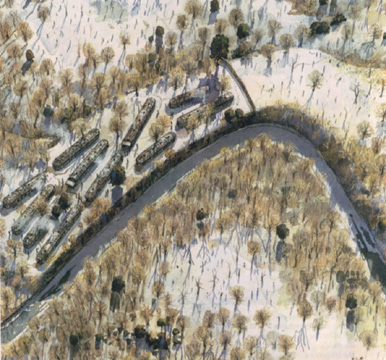What would the Native Americans
have been doing during our Christmas season? No one
really knows anymore exactly what their activities were
before the coming of the white men. There were eight
seasonal festivals celebrated by the nations of the
Iroquois Confederacy. However, the historical accounts of
these events were recorded well after Christianity and
European culture had influenced and changed the native
customs. The following account of an Onondagan
celebration is based on a report published in 1883.
The New Year or Midwinter Festival
began on the first new moon after the solstice. It was
the longest of the eight festivals, lasting almost three
weeks. It must have been a welcome break from the
monotony of winter, when the weather often required
spending a lot of time indoors. At the beginning of the
festival, the chiefs gathered and laid out their wampum
belts. Speeches were given, and confessions were made of
any wrongdoing in the past year. Then the feather dance,
a dance of peace, was performed.
Games were the next activity. The
Bear, Deer, Eel and Hawk Clans would join in a team to
play against the Wolf, Beaver, Snipe and Turtle Clans.
After the games, feasting and gambling were held in
separate houses for each clan. This meant that couples
were separated for this part of the festival, since it
was forbidden to marry someone from the same clan.
The village would gather together
again for the white dog ceremony. A pure white dog was
killed, decorated, and thrown into the fire as the
warriors shot arrows into the sun. This was an offering
to Aireskoui, the Sun god and god of war. It was probably
performed at this time, just after the darkest time of
the year, to thank the Aireskoui for the lengthening days
and slow return of the light.
Dancing was a big part of the New Year
Festival. The war dance was offered to the sun, moon,
stars, and thunder. The shuffle dance, in which one's
feet never leave the ground, was done by women only. The
guide dance was a couples dance, and marked the closing
of the festival.
However, seven days after the festival
ended, the medicine men would come to purify each house,
chasing away witches and disease. After this cleansing
ceremony, everyone gathered at the Council House. A
special dish was prepared for the medicine men. A large
pot of burnt corn, sweetened with maple syrup, was cooked
over a fire. The medicine men gathered the ashes from
this fire and threw them on everyone in the village to
protect them from witches and disease.
The Iroquois practice of confession of
past wrongs, purification of the people and the village
for the new year's beginning, and of course feasting and
dancing are all common themes found in New Year's
festivities around the world.
- Source:
- "Myths of the Iroquois," by
Erminnie A. Smith, 1883; reprinted by Iroqrafts Ltd.,
Ontario, Canada, 1989.
-
